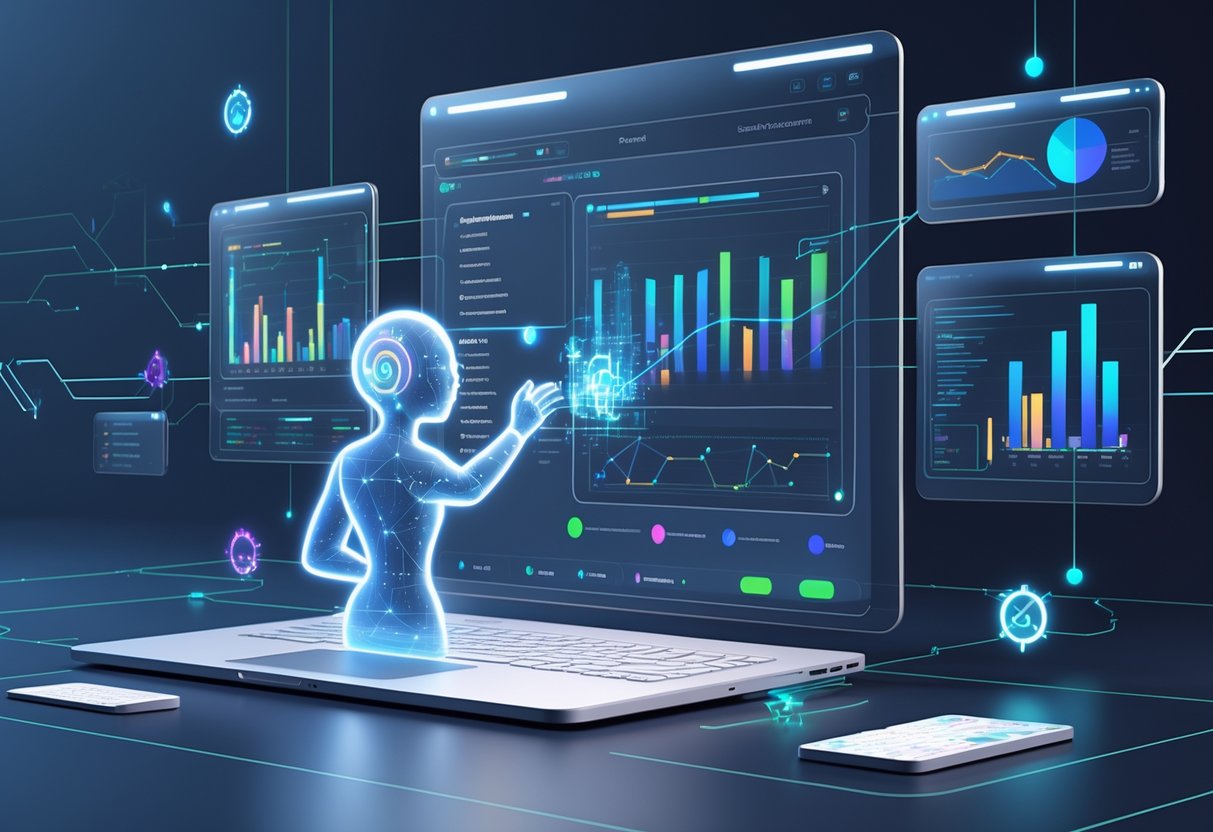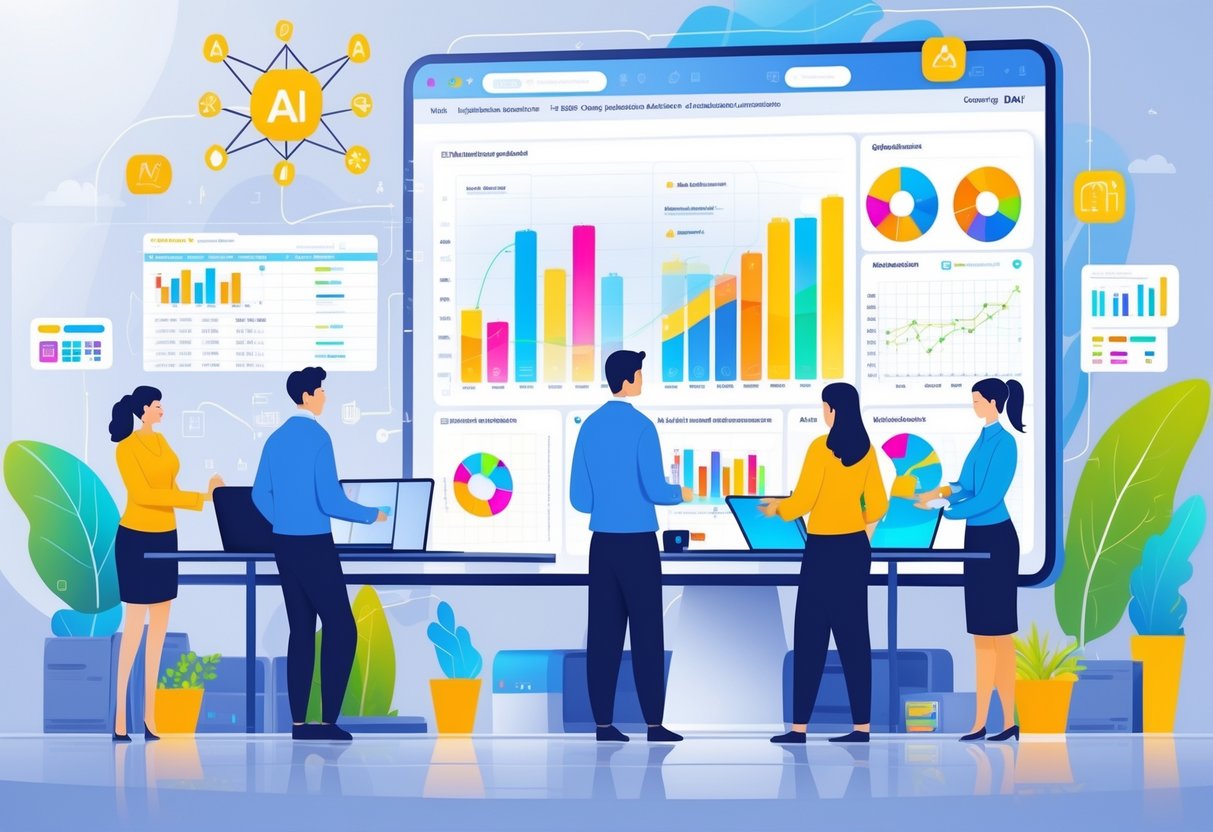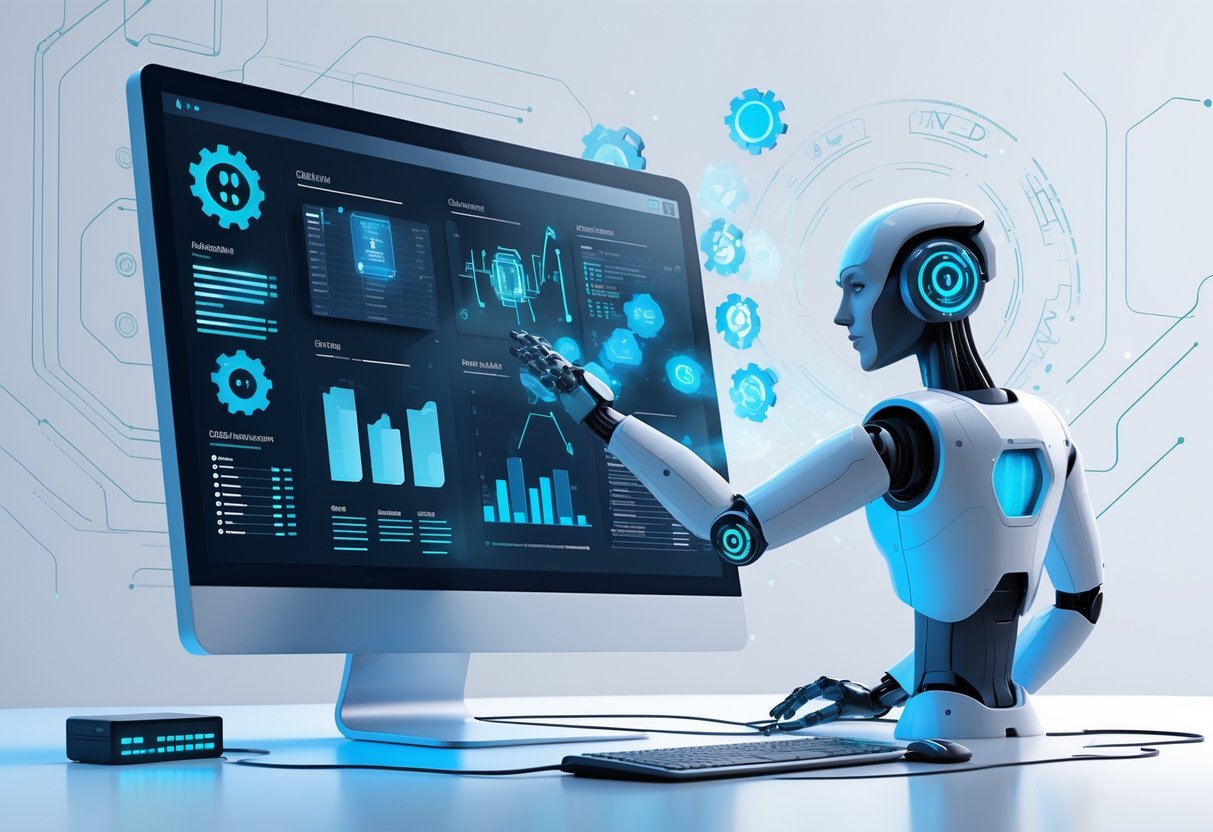Data cleaning takes up to 80% of a data analyst’s time, but artificial intelligence is changing that reality. Modern businesses deal with messy spreadsheets, duplicate records, and inconsistent formats that slow down important decisions. AI-powered data cleansing tools can automatically detect errors, remove duplicates, and standardize formats in minutes instead of hours or days.

These smart tools use machine learning to spot patterns humans might miss. They can fill in missing information, fix formatting problems, and clean entire databases without manual work. AI data cleaning tools in 2025 offer features like real-time processing and seamless integration with popular platforms like Excel and Google Sheets.
The right AI tool depends on specific needs and budget. Some work best for small teams using spreadsheets, while others handle enterprise databases with millions of records. This guide covers the essential features to look for, compares the most effective tools available, and explains how to integrate them into existing workflows for maximum impact.
Key Takeaways
- AI-powered tools reduce data cleaning time from hours to minutes through automated error detection and correction
- Modern solutions integrate directly with spreadsheets, CRM systems, and databases for seamless workflows
- Choosing the right tool depends on dataset size, technical requirements, and integration needs with existing systems
Why AI-Powered Data Cleansing is Essential

Poor data quality costs companies millions in lost productivity and flawed decisions, while AI-powered data cleaning adapts to new patterns and anomalies in real-time. Organizations need artificial intelligence to handle massive datasets efficiently and maintain the accuracy required for reliable analysis.
The Impact of Dirty Data on Analysis
Dirty data creates serious problems for businesses across all industries. Data inaccuracy costs companies an average of $15 million annually due to inefficiencies and lost productivity.
Common data quality issues include:
- Missing values in critical fields
- Duplicate records that skew results
- Inconsistent formatting across systems
- Outdated information that leads to poor decisions
These problems multiply when organizations rely on flawed data for analysis. Machine learning models trained on dirty data produce unreliable predictions and biased outcomes.
Sales teams waste time contacting wrong phone numbers or outdated email addresses. Marketing campaigns fail when customer data contains errors or duplicates.
Data analysis becomes meaningless when the underlying information lacks accuracy. Teams spend more time questioning results than making strategic decisions based on insights.
Benefits of Using AI for Data Cleaning
AI transforms data cleaning from a slow manual process into an automated system that works at scale. AI algorithms can quickly scan and process large volumes of data in real-time.
Key advantages include:
- Speed: Processes millions of records in minutes instead of weeks
- Accuracy: Identifies patterns humans might miss
- Consistency: Applies the same standards across all datasets
- Adaptability: Learns from new data types and formats
Machine learning algorithms detect anomalies and outliers automatically. They recognize when phone numbers have incorrect formats or when addresses contain typos.
AI systems standardize data formats without human intervention. They convert dates to consistent formats and fix capitalization issues across different sources.
The technology also handles complex data relationships. It can identify when two customer records actually represent the same person despite slight differences in spelling or contact information.
Challenges Solved by AI in Data Management
Traditional data cleansing methods struggle with modern data volumes and complexity. AI-powered approaches offer significant advantages over manual processes and rigid rule-based systems.
AI solves these specific challenges:
| Challenge | AI Solution |
|---|---|
| Large data volumes | Automated processing at scale |
| Missing data patterns | Predictive modeling for imputation |
| Inconsistent formats | Smart standardization rules |
| New data sources | Adaptive learning algorithms |
Organizations no longer need teams of analysts to manually review every record. AI handles routine cleaning tasks while humans focus on strategic data analysis.
The technology adapts to changing data sources and formats automatically. When companies integrate new systems, AI learns the data patterns without extensive reprogramming.
AI integration has transformed data quality management by learning from data patterns and continuously improving cleansing processes. This creates a self-improving system that gets better over time.
Complex data relationships become manageable with artificial intelligence. The technology identifies connections between different data points that would take humans weeks to discover manually.
Key Features of Modern AI Data Cleansing Tools

Modern AI-powered data cleaning tools use machine learning algorithms to automatically identify problems in datasets and fix them without human help. These tools can spot errors, remove duplicates, fill missing information, and make data consistent across different formats.
Automated Error Detection
AI algorithms scan datasets to find mistakes that humans might miss. They look for patterns that don’t match expected data types or values.
The systems check for common problems like wrong dates, invalid email addresses, and numbers outside normal ranges. Machine learning models learn what good data looks like by studying clean datasets.
AI data cleaning tools can spot subtle errors like typos in names or addresses. They use pattern recognition to find data that looks suspicious or unusual.
These tools work much faster than manual checking. They can process millions of records in minutes instead of days.
The AI gets better at finding errors over time. It learns from corrections and becomes more accurate at spotting similar problems.
Data Standardization and Normalization
AI tools convert data into consistent formats across entire datasets. They fix issues like different date formats, address styles, and naming conventions.
Standardization means making all similar data look the same. For example, converting “St.” to “Street” and “Ave” to “Avenue” in addresses.
The tools handle currency symbols, phone number formats, and measurement units. They can change “5 feet” to “60 inches” or “$100 USD” to “100.00” automatically.
AI for data cleaning includes smart text processing that fixes capitalization and spacing issues. It makes “john SMITH” become “John Smith” without losing important information.
These systems understand context when making changes. They know when “Apple” means the fruit versus the technology company.
Handling Missing Values and Outliers
AI algorithms predict what missing data should be based on other information in the dataset. They use statistical models to fill gaps with reasonable estimates.
The tools identify outliers that might be errors or genuinely unusual values. They flag data points that fall far outside normal ranges for review.
Smart imputation methods look at similar records to guess missing values. If someone’s age is blank but their job is “retired,” the AI might estimate they’re over 65.
Data validation processes check if extreme values make sense in context. A salary of $1 million might be correct for a CEO but wrong for an intern.
The systems can remove or flag suspicious outliers automatically. They balance keeping real but unusual data while removing obvious mistakes.
Data Deduplication and Validation
Fuzzy matching algorithms find duplicate records even when they’re not exactly identical. They compare records that are similar but not perfectly matching.
The tools spot duplicates like “John Smith, 123 Main St” and “J. Smith, 123 Main Street.” They understand these likely represent the same person.
Data deduplication uses confidence scores to rank how likely records are to be duplicates. Users can set thresholds for automatic removal or manual review.
Advanced fuzzy match techniques handle misspellings, abbreviations, and formatting differences. They can match “McDonald’s” with “McDonalds” or “MacDonald’s.”
The validation process checks if data follows business rules and logical constraints. It ensures email addresses have proper formats and phone numbers have the right number of digits.
Top AI-Powered Data Cleansing Tools to Try

These three tools stand out for their ability to handle complex data cleaning tasks with minimal manual effort. OpenRefine excels at transforming messy datasets, Trifacta uses machine learning for smart recommendations, and WinPure focuses on duplicate removal and matching.
OpenRefine
OpenRefine is a free, open-source tool that handles large datasets with ease. It works with multiple file formats including CSV, JSON, and XML files.
The software provides powerful clustering techniques for finding and removing duplicate records. Users can apply filters and transformations to clean messy data quickly.
Key Features:
- Advanced filtering and sorting options
- Data reconciliation with external sources like Wikidata
- Support for connecting to various databases
- Custom transformation functions
OpenRefine works well for researchers and analysts who need to clean survey data or combine datasets from different sources. The tool requires some learning but offers extensive documentation.
The platform handles millions of records without slowing down. Users can undo changes at any time, making it safe to experiment with different cleaning approaches.
Trifacta
Trifacta Wrangler uses machine learning to suggest data transformation steps automatically. The tool analyzes data patterns and recommends cleaning actions.
The drag-and-drop interface makes it easy for non-technical users to clean data. Visual previews show how changes will affect the dataset before applying them.
Main Benefits:
- AI-driven transformation suggestions
- Real-time data profiling
- Cloud storage integration
- Collaborative data preparation features
Trifacta connects to popular databases and cloud platforms like Amazon S3 and Google Cloud. Teams can share cleaning workflows and work together on the same datasets.
The tool automatically detects data quality issues like missing values and formatting problems. It generates cleaning scripts that can be reused for similar datasets.
WinPure
WinPure Clean & Match specializes in removing duplicate records from databases and spreadsheets. The software requires no coding knowledge to operate.
The tool works with Excel files, CSV documents, and database connections. It provides detailed reports showing exactly what duplicates were found and removed.
Core Capabilities:
- Real-time duplicate detection
- Fuzzy matching algorithms
- Data standardization features
- Multiple file format support
WinPure offers different matching rules for finding duplicates that aren’t exactly identical. Users can set custom criteria for what counts as a duplicate record.
The software processes data quickly and shows progress in real-time. It creates backup copies before making changes, protecting original data from accidental loss.
Innovative Solutions for Spreadsheets and Collaborative Workflows

Modern AI spreadsheet tools now integrate directly with popular platforms like Google Sheets and Excel. These solutions enable teams to clean data automatically while maintaining real-time collaboration features that traditional spreadsheets lack.
Spreadsheet AI and Numerous.ai
Numerous.ai stands out as a specialized spreadsheet AI tool that brings ChatGPT functionality directly into Excel and Google Sheets. The platform allows users to write AI-powered formulas using natural language commands.
Users can type simple instructions like “extract company names from this text” or “categorize these expenses.” The AI then generates the appropriate formulas automatically. This eliminates the need to learn complex formula syntax.
Key Features:
- Natural language formula generation
- Direct ChatGPT integration
- Support for both Excel and Google Sheets
- Automated data extraction and categorization
The tool excels at repetitive data cleaning tasks. It can standardize formats, remove duplicates, and validate entries across thousands of rows in seconds.
AI Integrations in Google Sheets
Google Sheets now includes built-in AI features through Duet AI and the Explore function. These tools automate data cleanup and generate insights without additional software installations.
The Explore feature analyzes data patterns and suggests charts or pivot tables automatically. Users simply ask questions in plain English about their data. The AI responds with relevant visualizations and summaries.
Smart Fill predicts data patterns and completes entries across columns. This feature works particularly well for cleaning inconsistent formatting in names, addresses, and categories.
Available AI Functions:
- Automated data cleanup – Detects and fixes formatting errors
- Dynamic pivot tables – Creates summaries from natural language queries
- Smart Fill – Predicts and completes data patterns automatically
- Chart recommendations – Suggests appropriate visualizations
These integrations work seamlessly within existing Google Workspace data workflows.
Collaborative Data Cleaning Platforms
Modern spreadsheet alternatives like Rows and Bricks focus on team collaboration while maintaining AI-powered cleaning capabilities. These platforms combine real-time editing with automated data processing.
Rows integrates GPT automation directly into spreadsheet cells. Multiple team members can work simultaneously while AI handles data validation and formatting tasks in the background.
Bricks transforms raw spreadsheet data into interactive dashboards automatically. The platform creates visual reports that update in real-time as team members modify the underlying data.
Collaboration Benefits:
- Real-time multi-user editing
- Automated data validation across team inputs
- Version control for data cleaning processes
- Shared AI-powered cleaning templates
These platforms maintain data accuracy while multiple users contribute to cleaning processes simultaneously.
AI Data Cleansing in CRM and ERP Applications

Modern businesses rely on CRM and ERP systems to manage critical customer and operational data. AI-powered tools automatically detect duplicates, standardize formats, and enrich missing information to maintain data accuracy across these enterprise platforms.
Enhancing Data Quality in CRM Systems
AI-driven CRM data cleaning tools transform customer relationship management by automatically identifying and correcting data inconsistencies. These systems detect duplicate contacts, standardize phone number formats, and validate email addresses in real-time.
Key CRM data quality improvements include:
- Duplicate detection – AI algorithms identify similar records across multiple fields
- Contact enrichment – Missing phone numbers, job titles, and company information get filled automatically
- Email validation – Invalid addresses are flagged before marketing campaigns launch
- Data standardization – Addresses, names, and company fields follow consistent formats
AI tools like folk CRM provide native enrichment capabilities that append firmographics and social profiles from public databases. The system continuously syncs updated contact information without manual intervention.
Automated data cleansing in platforms like Salesforce reduces manual effort while maintaining high-quality customer records. AI validates data entries, corrects formatting errors, and provides predictive insights about data quality trends.
ERP Data Cleansing Strategies
ERP systems require clean data across inventory, financial, and operational modules to function effectively. AI data cleansing tools validate product codes, standardize vendor information, and ensure data consistency between departments.
Critical ERP data cleansing areas:
- Vendor master data – Company names, addresses, and tax IDs maintain uniform formatting
- Product catalogs – Item descriptions, SKUs, and pricing follow standard conventions
- Financial records – Account codes and transaction data meet compliance requirements
- Inventory management – Stock levels and location data remain accurate across warehouses
AI-powered data cleaning tools handle complex ERP datasets by validating information in real-time. These systems prevent data quality issues from spreading across integrated business processes.
Manufacturing companies benefit from AI tools that standardize part numbers and supplier information. The technology ensures procurement teams work with accurate vendor data while maintaining compliance with industry regulations.
Integrating AI Tools Into Your Data Cleaning Process

Successfully implementing AI tools requires proper data preparation, following proven implementation practices, and maintaining strict security protocols. These steps ensure maximum effectiveness while protecting sensitive information throughout the cleaning process.
Preparing Data for AI Cleansing
Organizations must format their data correctly before AI tools can process it effectively. Most AI-powered data cleaning tools work best with structured formats like CSV, Excel, or JSON files.
Data entry consistency becomes critical at this stage. Teams should standardize column headers and ensure uniform data formats across all datasets. For example, dates should follow the same pattern (MM/DD/YYYY) and text fields should use consistent capitalization.
Essential preparation steps include:
- Removing obvious formatting errors manually
- Standardizing file formats across all data sources
- Creating backup copies of original datasets
- Documenting data entry rules and conventions
The size of datasets matters significantly. Many AI tools perform better when processing data in smaller batches rather than massive files. Breaking large datasets into manageable chunks of 10,000-50,000 rows often produces better results.
Teams should also identify which columns contain the most errors. Focusing AI tools on problematic areas first maximizes cleaning efficiency.
Best Practices for Implementation
Start with pilot projects using non-critical data to test tool performance. This approach allows teams to understand how specific AI tools handle their unique data cleaning process requirements.
Key implementation strategies:
| Phase | Action | Timeline |
|---|---|---|
| Testing | Run small sample datasets | 1-2 weeks |
| Training | Learn tool features thoroughly | 2-3 weeks |
| Rollout | Implement on larger datasets | 4-6 weeks |
Define clear success metrics before beginning. These might include error reduction percentages, time savings, or data accuracy improvements. Teams should measure results consistently across all cleaning projects.
Integration with existing workflows requires careful planning. AI tools for data cleaning work best when they connect seamlessly with current database systems and reporting tools.
Regular validation checks remain essential even with AI assistance. Human oversight ensures the tools produce expected results and catch any algorithmic errors or biases.
Ensuring Data Security and Compliance
Data security protocols must be established before implementing any AI cleaning tools. Organizations handling sensitive information need tools that process data locally rather than sending it to external servers.
Critical security measures include:
- Encryption of all data files during processing
- Access controls limiting who can use cleaning tools
- Audit trails tracking all data modifications
- Compliance checks ensuring regulatory requirements are met
Many industries have specific data handling requirements. Healthcare organizations must follow HIPAA guidelines, while financial companies need SOX compliance. The chosen AI tools must support these regulatory frameworks.
Cloud-based cleaning tools require additional security considerations. Teams should verify where data gets processed and stored. Some tools offer on-premises deployment options for maximum data security control.
Regular security audits become more important when using AI tools. Organizations should monitor how these tools access, process, and store their data throughout the entire data cleaning process.
Data retention policies need updating to account for AI tool usage. Clear guidelines should specify how long processed data remains in tool systems and when it gets permanently deleted.
Emerging Trends and Future of AI in Data Cleansing

Machine learning algorithms are becoming smarter at detecting complex data patterns and errors. AI-powered data curation systems now handle real-time processing while expanding beyond basic cleaning to include sentiment analysis and advanced business intelligence capabilities.
Advances in Machine Learning Models
Modern machine learning algorithms can identify subtle data inconsistencies that traditional methods miss. These systems learn from previous cleaning tasks to improve accuracy over time.
AI-powered approaches using machine learning algorithms and natural language processing show significant advantages over traditional techniques. The models can handle complex data preprocessing tasks automatically.
Advanced algorithms now detect anomalies in real-time. They spot patterns in messy datasets that would take humans hours to find.
Key improvements include:
- Pattern recognition for duplicate detection
- Automated error classification
- Predictive data validation
- Self-learning cleanup rules
These models work across different data types. They handle text, numbers, dates, and mixed formats with equal effectiveness.
Real-Time Data Cleaning and Automation
Real-time data processing systems clean information as it enters databases. This prevents dirty data from accumulating and causing problems later.
Organizations can now validate data instantly. Errors get flagged and fixed before they spread through systems.
Automated workflows trigger cleaning processes without human input. These systems monitor data quality continuously and respond to issues immediately.
Benefits of real-time cleaning:
- Instant error detection
- Reduced data backlogs
- Consistent quality standards
- Lower manual oversight needs
AI systems handle complex and large-scale data cleaning tasks while validating information in real-time. This capability transforms how organizations manage data quality.
From Data Cleaning to Sentiment Analysis
AI tools now expand beyond basic cleaning to extract meaningful insights from text data. Sentiment analysis has become a standard feature in modern data preprocessing platforms.
These systems can categorize customer feedback automatically. They identify positive, negative, and neutral sentiments while cleaning the underlying data.
Advanced text processing includes:
- Emotion detection in reviews
- Topic classification
- Intent recognition
- Language standardization
Data transformation processes now incorporate sentiment scoring. This helps businesses understand customer opinions while ensuring data quality.
Organizations use these capabilities for market research and customer service improvements. The same tools that clean data also provide actionable business insights.
Business Intelligence and Data Insights
AI-enhanced data cleansing tools generate insights that empower faster decision-making. Clean data becomes the foundation for reliable business intelligence systems.
Modern platforms provide data quality scores and recommendations. They show which datasets need attention and suggest improvement strategies.
Intelligence features include:
- Data completeness metrics
- Error rate tracking
- Quality trend analysis
- Automated reporting dashboards
These systems identify data collection problems before they impact analysis. Business intelligence tools can then work with higher-quality information.
Organizations gain visibility into their data health. They can track improvements over time and measure the impact of cleaning efforts on business outcomes.
Frequently Asked Questions

Python developers have access to specialized libraries like Pandas AI, while free tools such as OpenRefine provide robust AI features without cost. Excel users can leverage AI-powered alternatives that offer superior automation compared to traditional spreadsheet functions.
What are the top data cleaning tools currently available for Python developers?
Pandas AI stands out as the leading Python-based library for developers working with data cleaning tasks. This enhanced version of the popular Pandas library includes artificial intelligence features that simplify complex data manipulation processes.
The tool offers AI-augmented functions that automatically fill missing values and correct errors in datasets. Developers can create custom workflows using Python scripting while processing millions of rows efficiently.
DataRobot provides another powerful option for Python developers focused on machine learning applications. It automates data preprocessing tasks and integrates seamlessly with existing analytics tools.
Advanced cleaning algorithms in DataRobot detect outliers, fill data gaps, and remove errors automatically. The platform generates automated insights during the cleaning process to improve overall data quality.
Which free data cleansing solutions offer the best AI capabilities?
OpenRefine leads the free data cleaning tools with its open-source approach and extensive plugin support. Users can transform raw datasets into structured formats without paying licensing fees.
The platform excels at duplicate removal and data transformation tasks. Its plugin ecosystem extends functionality for advanced data handling requirements across different industries.
DataWrangler offers another free option developed by Stanford University for interactive data cleaning. The tool provides visual data cleaning capabilities with pattern recognition features.
Students and researchers benefit from its completely free licensing for non-commercial use. The interactive interface allows users to clean and reshape data through visual manipulation tools.
Explore hands-on data cleaning exercises to practice these techniques.
How do Excel-based data cleaning tools compare to AI-powered alternatives?
Traditional Excel functions require manual setup and lack intelligent automation features found in AI-powered tools. Users must create formulas and macros to handle repetitive cleaning tasks that AI tools complete automatically.
AI-powered alternatives process entire datasets within seconds using simple prompts. These tools standardize formats, remove duplicates, and correct inconsistencies without manual intervention.
Excel struggles with large datasets that contain millions of rows or complex data types. AI tools handle scalability issues and process various data formats including text, numbers, and multimedia content.
Error detection in Excel depends on user knowledge and manual review processes. AI tools automatically identify patterns, outliers, and inconsistencies that humans might miss during manual inspection.
Test your data cleaning skills with interactive quizzes.
What are some effective techniques for data cleaning in data analytics?
Automated error detection represents the most effective technique for identifying inconsistencies and outliers in large datasets. This approach saves significant time compared to manual review processes while reducing human error rates.
Data standardization ensures all entries follow consistent formatting conventions across different data sources. Converting dates to uniform formats and normalizing text fields improves compatibility with analysis tools.
Missing data handling techniques include predictive modeling and statistical imputation methods. These approaches fill gaps in datasets using intelligent algorithms rather than simply removing incomplete records.
Duplicate removal processes automatically identify and merge identical entries that could skew analytical results. Advanced algorithms compare multiple fields to detect subtle duplications across large databases.
Practice these techniques in real-world scenarios with premium data projects.
Can OpenRefine be integrated with AI for enhanced data cleansing workflows?
OpenRefine supports plugin extensions that can incorporate AI capabilities into standard data cleaning workflows. Third-party developers create plugins that add machine learning features to the base platform.
The tool’s architecture allows integration with external AI services through API connections. Users can send data to AI platforms for processing and import cleaned results back into OpenRefine projects.
Custom scripting capabilities enable advanced users to connect OpenRefine with Python-based AI libraries. This integration combines OpenRefine’s user interface with powerful machine learning algorithms for enhanced cleaning.
Workflow automation becomes possible when combining OpenRefine with AI tools for repetitive cleaning tasks. Users can create templates that apply AI-enhanced cleaning rules to similar datasets automatically.
If you want to deepen your understanding, consider enrolling in our analytics engineering course.
What are the advantages of using AI tools over traditional methods for data cleaning?
AI tools complete data cleaning tasks in minutes that would take hours or days using traditional manual methods. Automation eliminates the time-consuming process of reviewing each data entry individually.
Pattern recognition capabilities in AI tools identify inconsistencies that humans frequently overlook during manual inspection. Machine learning algorithms detect subtle errors and anomalies across massive datasets with high accuracy rates. For more on practical data cleaning exercises, see our practice exercises.
Scalability becomes manageable with AI tools that process millions of records without performance degradation. Traditional methods struggle with large datasets and require significant human resources to complete cleaning tasks.
AI-powered tools reduce human error rates while maintaining consistent cleaning standards across different projects. Automated processes apply the same quality criteria uniformly without variation in attention or accuracy. To further your understanding, explore our premium projects.




